Menus
- Cabin scooter and recreational bike in one
- Roof construction made of carbon
- survey
- Removable roof
- Crumple zone, seat belt, airbags
- Conclusion
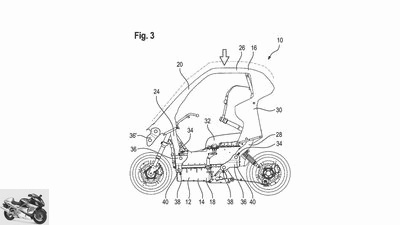
BMW
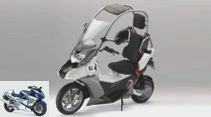
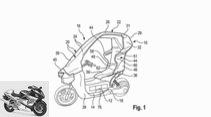
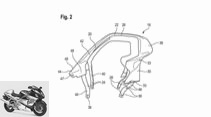
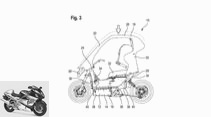
11 photos
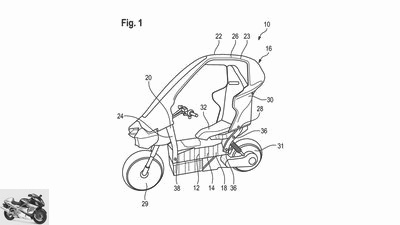
BMW
1/11
The patent drawing is reminiscent of the BMW C1 cabin scooter.
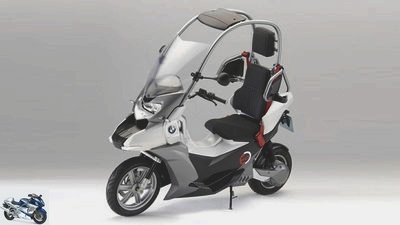
Manufacturer
2/11
It was only built from 2000 to 2003 and did not sell well. But it left a lasting impression.
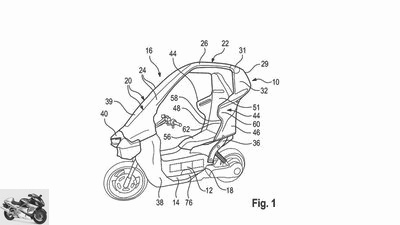
BMW
3/11
And BMW would like to venture a new attempt in the field of cabin scooters.
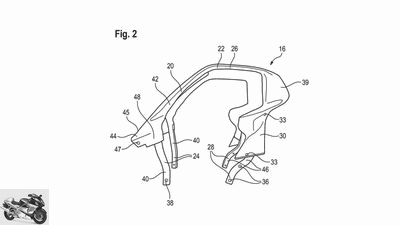
BMW
4/11
This time it should be a roof structure made of carbon.
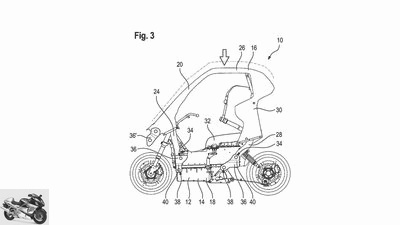
BMW
5/11
The sketches foresee 4 crumple zones, designed to absorb impact energy and easily interchangeable after an impact.
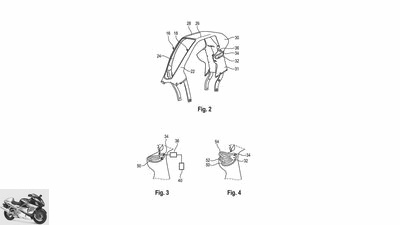
BMW
6/11
Four movable winglets on the roof structure are supposed to ensure stability in spite of cross winds.
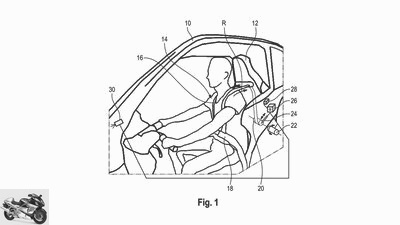
BMW
7/11
A four-point belt is intended to keep the driver in his safety cell in the event of an accident.
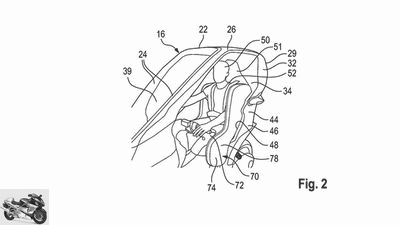
BMW
8/11
The airbags are built into the side panel and are intended to protect the area from the hips to the shoulders and from the elbows.
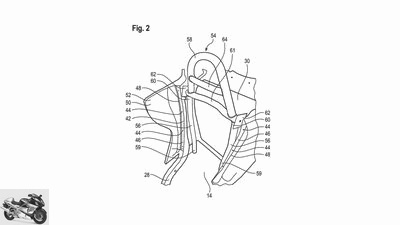
BMW
9/11
The driver’s seat is with a "Protective cage" equipped for the back and inflatable pads.
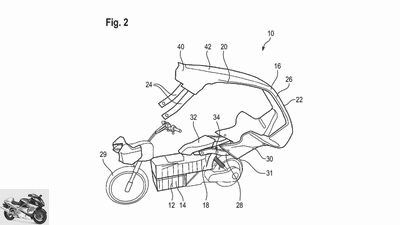
BMW
10/11
The highlight: The roof should be removable so that the vehicle can not only be used as a commuter bike with extra protection, but also for "completely normal" Country road tours.

Manufacturer
11/11
The chassis, batteries and drive could come from the parts shelf of the BMW C Evolution e-scooter.
BMW patent for new hybrid vehicle
Cabin scooter and recreational bike in one
The European patent office published drawings showing a BMW electric scooter with a removable roof, seat belts and airbags.
R.oller with a roof – does it sound familiar? Sure, the unforgettable BMW C1 is immediately in the picture. It was built for just three years, from 2000 to 2003. A new BMW cabin scooter could not be called C1, however, as BMW sold the name in 2004 to the automobile manufacturer Citroën, which calls its small car that. It’s a shame, because C1 Evolution could fit in well – as a reference to the C1 and the C Evolution. It stands to reason that the concept – if it is ever implemented – will use the chassis, batteries and drive on the parts shelf of the C Evolution.
Roof construction made of carbon
The published information on the current BMW patent already reveals that a possible new cabin scooter could be equipped with a roof made of carbon fiber and an aluminum platform. Two carbon arches form the main structure of the roof. They run approximately from the driver’s foot level above his head and open onto a swiveling suspension behind the driver. Carbon offers high rigidity with minimal weight, but it also costs significantly more than aluminum.
survey
Voted 1262 times
Could you imagine using such a hybrid vehicle??
Sure, during the week to commute – well protected, even against wind and weather. And on the weekend without a security cell for an exit.
Absolutely no way. Better with a helmet and without airbags, weather protection, etc. on the bike – whether to work or on a country road tour.
read more
Propulsion of the BMC C Evolution
The C1 at the time had an aluminum roof and weighed 185 kilograms, which was a bit overwhelming for the 125 single-cylinder with 15 hp and a top speed of 110 km / h. The successor C1 200 with 176 cm³ displacement and almost 18 hp improved the acceleration values, but the top speed only rose to 112 km / h. The large electric scooter C Evolution currently available from BMW provides 48 hp, drives up to 129 km / h and has a range of 160 kilometers. So that would be useful performance data.
Manufacturer
Removable roof
The entire roof structure should be easy to remove – including winglets, safety cell with airbags, four-point belt, backrest and windshield. It seems as if BMW is pursuing a vehicle concept with this design that, for example, meets the needs of a commuter during the week and should resemble a completely normal motorcycle as much as possible for an excursion on the weekend – albeit electric.
Crumple zone, seat belt, airbags
The patent drawings provide for four crumple zones of several centimeters vertically through the brackets of the carbon roof at the front and rear (see Fig. 3, dashed lines at the numbers 40).
BMW
The sketches foresee 4 crumple zones, designed to absorb impact energy and easily interchangeable after an impact.
A four-point belt is intended to keep the driver in the seat in the event of a collision, so that the airbags in the side walls of the cabin can effectively protect the driver. The airbags should reach from the hips up to the shoulder and up to the elbows on each side. The reinforced back area on the detachable cabin is intended to protect the spine in the event of a rear-end collision, and inflatable cushions are also provided in this area.
Winglets against sensitivity to cross winds
The roof construction provides more protection against injuries in the event of an accident as well as against wind and rain, but aerodynamically – especially in crosswinds – it creates challenges.
BMW
4 movable winglets on the roof structure should ensure stability in spite of cross winds.
For this purpose, BMW provides four movable winglets in the patent drawings: In conjunction with an electronic stability system, two winglets at the front and two at the rear provide downforce. At the same time, they could act like the ailerons on an airplane. The small, moving components would constantly align themselves in such a way that they counteract the tilting forces generated by the cross winds and thus stabilize the vehicle.
And what about a pillion passenger?
With the C1 it was possible to take a passenger with you, but only in theory. The passenger had to take a seat outside or behind the cabin. And then of course wear a helmet. Very few have made use of this option to take them away. The current drawings suggest that there is no space provided for a passenger in this cabin vehicle, and certainly none that is located inside the safety cell. It could look different if the roof is removed. On the "completely normal" Outdoor bike could then already be space for a pillion passenger.
Conclusion
BMW is obviously serious about this idea. The first patent for this was applied for in 2019, this is a removable roof for the C Evolution electric scooter. 15 new patent documents show that the concept has developed considerably since then.
Related articles
-
Xiaomi Ninebot C30: electric scooter at a bike price
Xiaomi Xiaomi Ninebot C30 electric scooter at bike price The electronics giant Xiaomi has launched the new Ninebot C30 electric scooter in China …
-
Harley-Davidson electric scooter: patented city runabout
New items for 2021 Motorcycle innovations 2021 Harley-Davidson 11 photos Harley-Davidson 1/11 As announced, Harley-Davidson is working on electrically…
-
Honda patent for electric Super Cub with removable battery
Honda 7th photos Honda 1/7 In 2015 Honda presented a Super Cub with an electric motor as a concept bike at the Tokyo Motor Show. Honda 2/7 In 2016, the…
-
Aprilia Tuono 660 (2020): Patent drawings confirm production model
Motorcycle fair in Milan EICMA 2019 Presented by Aprilia 14th photos Jorg Kunstle 1/14 Aprilia presented a new concept bike at EICMA. Jorg Kunstle 2/14…
-
IO Hawk Exit Cross E-Scooter: Kick scooter test off-road
Jiri Pekarek 22nd photos Jiri Pekarek 1/22 Stones like this are a size too big for the Exit Cross. Mona Pekarek 2/22 He does well in the meadow. Mona…
-
DragonTT MP1 Dynamic CL: three-wheeled vehicle with a roof
5 pictures DragonTT 1/5 This tricycle is called MP1 Dynamic CL and is put on the wheels by the Spanish manufacturer DragonTT. 2/5 Due to the …
-
Concept comparison Enduro versus Naked Bike
Concept comparison Enduro versus Naked Bike Double Boxer High or low? With or without a windbreak? Small wide or large studded tires? Better a naked …
-
Retro bike Harley-Davidson Softail Slim
10 photos 1/10 Harley-Davidson Softail Slim: 103 cubic inches correspond to 1690 cm³. 2/10 Harley-Davidson Softail…
-
Scooter with chair as seat: police stop idiosyncratic conversion
Rhineland-Palatinate police. Scooter with armchair as a seat Police stop idiosyncratic reconstruction The police stopped a scooter driver at a traffic…
-
Suzuki Burgman 400 Z – Comfortable scooter
www.bilski-fotografie.de In the test: Suzuki Burgman 400 Z Very comfortable Suzuki scooter The Suzuki Burgman 400 Z large scooter combines comfort and…